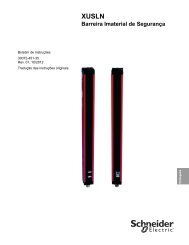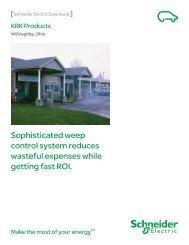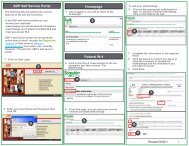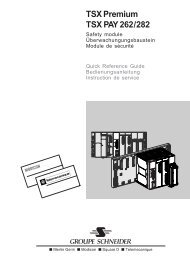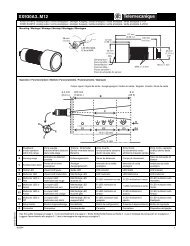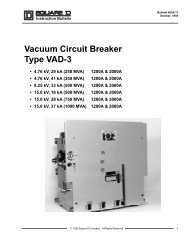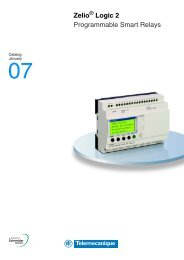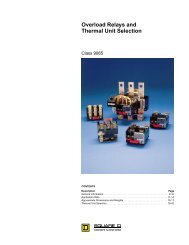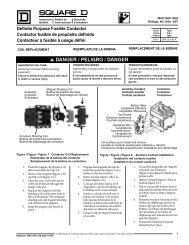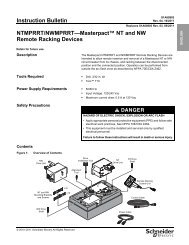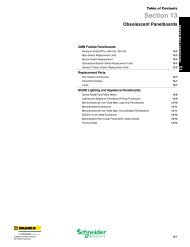Seven Trends for the Future of Mining Automation - Schneider Electric
Seven Trends for the Future of Mining Automation - Schneider Electric
Seven Trends for the Future of Mining Automation - Schneider Electric
Create successful ePaper yourself
Turn your PDF publications into a flip-book with our unique Google optimized e-Paper software.
<strong>Seven</strong> <strong>Trends</strong> <strong>for</strong> <strong>the</strong> <strong>Future</strong><br />
<strong>of</strong> <strong>Mining</strong> <strong>Automation</strong><br />
by Fabio Mielli, U.S. <strong>Mining</strong>,<br />
Metals and Minerals Segment Manager<br />
<strong>Schneider</strong> <strong>Electric</strong> USA, Inc.<br />
Make <strong>the</strong> most <strong>of</strong> your energy SM
Summary<br />
Introduction ....................................................................................................... p 3<br />
<strong>Seven</strong> <strong>Trends</strong> <strong>for</strong> <strong>the</strong> <strong>Future</strong> <strong>of</strong> <strong>Mining</strong> <strong>Automation</strong> .............................................. p 4<br />
• Trend 1 — Using In<strong>for</strong>mation Systems to Achieve Data Integration<br />
and Customized User Aggregation ................................................................. p 4<br />
• Trend 2 — Energy as Process Variable: Solving <strong>the</strong> Lack <strong>of</strong><br />
Integration Between Plant In<strong>for</strong>mation and Energy In<strong>for</strong>mation ........................ p 5<br />
• Trend 3 — Internet and E<strong>the</strong>rnet Technologies in <strong>the</strong> Field .............................. p 6<br />
• Trend 4 — Centralized Operation and Monitoring ............................................ p 6<br />
• Trend 5 — Wireless ........................................................................................ p 6<br />
• Trend 6 — Autonomous Systems ................................................................... p 7<br />
• Trend 7 — Image and Video as Process Tools ................................................ p 7<br />
Evolving Operations ........................................................................................... p 8<br />
About <strong>the</strong> Author ............................................................................................... p 8
Introduction<br />
<strong>Mining</strong> is a complex industry. Extracting raw material in different shapes, sizes and<br />
chemistries from <strong>the</strong> earth’s crust and trans<strong>for</strong>ming it into a standardized and high<br />
quality final product is a challenging process. Not to mention that it involves huge<br />
material movement, scheduling, synchronization and tracking — all on a large<br />
scale. It’s like a manufacturing plant but with no tagged boxes.<br />
<strong>Automation</strong> plays an important role in <strong>the</strong> mine environment. However, <strong>for</strong> <strong>the</strong><br />
majority <strong>of</strong> those in <strong>the</strong> mining industry, automation is a much larger concept than<br />
regulatory systems, supervision and instrumentation. <strong>Automation</strong> can cover <strong>the</strong><br />
geological/geographical in<strong>for</strong>mation systems s<strong>of</strong>tware to autonomous machines,<br />
and from mine execution s<strong>of</strong>tware to optimization or expert systems.<br />
As automation in <strong>the</strong> mining world evolves, <strong>the</strong>re are seven trends that likely will<br />
help shape its future.<br />
<strong>Seven</strong> trends <strong>for</strong> <strong>the</strong> future <strong>of</strong> mining automation<br />
White paper <strong>for</strong> mining automation | 3
<strong>Seven</strong> trends <strong>for</strong> <strong>the</strong> future <strong>of</strong> mining automation<br />
<strong>Seven</strong> <strong>Trends</strong> <strong>for</strong> <strong>the</strong> <strong>Future</strong> <strong>of</strong><br />
<strong>Mining</strong> <strong>Automation</strong><br />
Ampla<br />
Configuration<br />
Studio<br />
Ampla<br />
Unified Configuration<br />
MES Solutions<br />
Delay<br />
accounting<br />
Trend 1:<br />
Using in<strong>for</strong>mation systems to achieve<br />
data integration and customized<br />
user aggregation<br />
In some mining operations <strong>the</strong>re can be an excess<br />
<strong>of</strong> in<strong>for</strong>mation. A myriad <strong>of</strong> dissimilar and sometimes<br />
proprietary systems, such as process control, ERP,<br />
MES, laboratory in<strong>for</strong>mation management system<br />
(LIMS), process in<strong>for</strong>mation management system<br />
(PIMS), quality control, asset management, fleet<br />
management, geographic in<strong>for</strong>mation system (GIS)<br />
and energy management systems are delivering tons<br />
<strong>of</strong> data that can be useless if not treated, filtered and<br />
integrated in a meaningful way.<br />
Ampla<br />
Production<br />
Analysis<br />
Application Services<br />
Communication<br />
Infrastructure<br />
MES Services<br />
Data Store<br />
SQL Server<br />
Production<br />
Energy<br />
Optimization<br />
Metal<br />
accounting<br />
Reports Dashboards Master<br />
Data<br />
SSRS<br />
Server<br />
Public<br />
Interface<br />
Data Collection<br />
Real Time<br />
Connectors<br />
SCADA<br />
OPC Server<br />
Integration Services<br />
Master Data<br />
Synchronization<br />
Historical<br />
Connections<br />
Historian<br />
When not properly connected, <strong>the</strong>se applications<br />
make more work through isolated databases, and<br />
duplicate data and spreadsheets. Then manual<br />
entries or custom homemade s<strong>of</strong>tware (middleware)<br />
is required to interface among <strong>the</strong> applications.<br />
To combat this dilemma, mining operations are<br />
moving to IT solutions and architectures to integrate<br />
dissimilar applications in a proper way to achieve<br />
common in<strong>for</strong>mation, centralize data and better data<br />
exchange and orchestration. In addition, individual<br />
vendors’ systems need to be friendlier and use open<br />
standards so in<strong>for</strong>mation is accessible.<br />
B2MML<br />
Interface<br />
Oracle/SQL<br />
Server<br />
ESB<br />
Data<br />
Integration<br />
Workflow<br />
ETL<br />
Downtime Production Metrics Inventory Energy Tracking<br />
Quality Planning Knowledge Cost<br />
Mine in<strong>for</strong>mation integration and orchestration from different data sources<br />
4 | White paper <strong>for</strong> mining automation<br />
Enterprise Resource Planning (ERP)<br />
Maintenance<br />
Fleet<br />
Management<br />
LIMS<br />
Energy<br />
Forecasting
Customized user aggregation<br />
Using data aggregation, a production manager is<br />
able to customize his/her personal computer screen<br />
to show energy efficiency in<strong>for</strong>mation, particle size,<br />
grade, cost and emissions. All he/she needs to do<br />
is drag and drop <strong>the</strong> KPIs, reports and trends that<br />
are important <strong>for</strong> his/her current needs, even if <strong>the</strong><br />
in<strong>for</strong>mation is coming from different sources and layers.<br />
In a higher level, a plant manager can aggregate<br />
and visualize even more in<strong>for</strong>mation, not necessarily<br />
limited to process in<strong>for</strong>mation. Energy and utilities<br />
consumption from <strong>the</strong> <strong>of</strong>fice buildings, along with IT<br />
and processing units can be aggregated in a single<br />
screen. Basically, users can customize <strong>the</strong>ir screen<br />
with in<strong>for</strong>mation relevant <strong>for</strong> <strong>the</strong>ir needs from all<br />
available data sources.<br />
A production manager will be able to customize<br />
his/her personal computer screen to aggregate<br />
data that is important <strong>for</strong> his/her current needs<br />
Trend 2:<br />
Energy as process variable: solving<br />
<strong>the</strong> lack <strong>of</strong> integration between plant<br />
in<strong>for</strong>mation and energy in<strong>for</strong>mation<br />
Users need a deeper understanding <strong>of</strong> how energy<br />
is used and <strong>the</strong> ability to identify <strong>the</strong> drivers and root<br />
causes <strong>for</strong> increased energy consumption per unit<br />
<strong>of</strong> production. This understanding requires timely<br />
access to accurate energy in<strong>for</strong>mation, as well as <strong>the</strong><br />
operational context <strong>of</strong> how that energy was used.<br />
Some users have <strong>the</strong> energy consumption in<strong>for</strong>mation,<br />
that is not cross-referenced with production<br />
in<strong>for</strong>mation. O<strong>the</strong>r users cannot identify <strong>the</strong> difference<br />
between overconsumption generated by legitimate<br />
process requirements from overconsumption caused<br />
by problems or under per<strong>for</strong>mance.<br />
Energy in a process context: average kWH per ton<br />
by feed type<br />
In <strong>the</strong>se situations, energy <strong>for</strong>ecasting is challenging<br />
since <strong>the</strong>re is no single, complete model about how<br />
energy has been used.<br />
For many years it was very common <strong>for</strong> energy and<br />
process control to be managed by two separate<br />
departments — classic in<strong>for</strong>mation silos with no<br />
connection or combined analysis. Today, however, it<br />
is almost impossible <strong>for</strong> <strong>the</strong> two not to be linked since<br />
energy efficiency is intrinsically tied to process control<br />
optimization. Physical and data integration between<br />
production, control and power allows users to link<br />
process per<strong>for</strong>mance with energy management,<br />
quality and efficiency. Energy in<strong>for</strong>mation also can be<br />
used <strong>for</strong> online process optimization.<br />
The takeaway is that it’s important to have online<br />
energy efficiency in<strong>for</strong>mation in a process context.<br />
This also allows operators to manage energy<br />
consumption and its costs, as well as evaluate <strong>the</strong><br />
impact <strong>of</strong> <strong>the</strong>ir decisions — a perfect integration<br />
between power and control systems.<br />
<strong>Seven</strong> trends <strong>for</strong> <strong>the</strong> future <strong>of</strong> mining automation<br />
White paper <strong>for</strong> mining automation | 5
<strong>Seven</strong> trends <strong>for</strong> <strong>the</strong> future <strong>of</strong> mining automation<br />
<strong>Seven</strong> <strong>Trends</strong> <strong>for</strong> <strong>the</strong> <strong>Future</strong> <strong>of</strong><br />
<strong>Mining</strong> <strong>Automation</strong> (cont.)<br />
6 | White paper <strong>for</strong> mining automation<br />
Trend 3:<br />
Internet and E<strong>the</strong>rnet technologies<br />
in <strong>the</strong> field<br />
Useful data from field and control systems can have<br />
a transparent route to <strong>the</strong> production and business<br />
application layers <strong>of</strong> a mine operation and become<br />
an important source <strong>of</strong> in<strong>for</strong>mation to minimize data<br />
entry, retyping and even mistakes. Most importantly,<br />
<strong>the</strong> in<strong>for</strong>mation is coming from <strong>the</strong> actual process.<br />
Devices including instrumentation, online analyzers,<br />
motor control, and dedicated devices such as<br />
weighing and gas emissions, that are linked to<br />
E<strong>the</strong>rnet networks allow users to obtain data,<br />
visualize, configure and maintain <strong>the</strong>se devices in a<br />
wider plant approach — not restricted and isolated<br />
by process area. Embedded web servers allow users<br />
access to monitor and configure devices, simply by<br />
using commercial web browsers. An open industrial<br />
E<strong>the</strong>rnet network saves users proprietary s<strong>of</strong>tware<br />
costs and <strong>of</strong>fers more intuitive tools. This technology<br />
also allows users to customize <strong>the</strong>ir device “home<br />
page” according to <strong>the</strong>ir requirements. An email<br />
server notifies users if something goes wrong or if<br />
variables are at a critical level.<br />
At <strong>the</strong> plant level, E<strong>the</strong>rnet and internet technologies<br />
permit remote plant access, down to <strong>the</strong> device<br />
level, so isolated mines can be monitored and<br />
even maintained.<br />
Trend 4:<br />
Centralized operation and monitoring<br />
An up-and-coming concept in mining operations<br />
is <strong>the</strong> use <strong>of</strong> a central, virtual control room. The<br />
central control room monitors several mines in<br />
distant locations from a single location. Central<br />
control rooms, <strong>for</strong> example, can monitor all energy<br />
consumption from different units and compare<br />
<strong>the</strong> per<strong>for</strong>mance among different plants down to<br />
<strong>the</strong> equipment level and loads, all from a single<br />
location. From a business perspective, this facilitates<br />
benchmarking and comparisons <strong>of</strong> <strong>the</strong> same<br />
processes at different plants.<br />
An advanced concept <strong>of</strong> virtual control rooms<br />
includes a user who outsources remote monitoring<br />
to ano<strong>the</strong>r company and <strong>the</strong> technology supplier<br />
manages <strong>the</strong> user in<strong>for</strong>mation and historic data in<br />
virtual servers.<br />
Trend 5:<br />
Wireless<br />
For years, radio communication has been used in<br />
<strong>the</strong> mine environment, <strong>for</strong> example stacker reclaimer<br />
machine communication, remote pump systems in<br />
isolated locations or fleet control communications.<br />
But <strong>the</strong> world is becoming more and more wireless<br />
and <strong>the</strong> next logical step <strong>for</strong> this proven technology is<br />
industry and <strong>the</strong> plant floor.<br />
Wireless sensors, RFID material and personal<br />
tracking, condition monitoring and data acquisition<br />
are all becoming more common and finding<br />
applications in <strong>the</strong> mine industry. Some mining<br />
companies have tested tags that are blended with<br />
iron ore pellets <strong>for</strong> traceability purposes. In addition,<br />
wireless technologies are migrating to instruments<br />
and device networks <strong>for</strong> a more efficient monitoring<br />
and asset management strategy.<br />
These types <strong>of</strong> wireless technology applications<br />
are “safe ground.” However, wireless is facing two<br />
big challenges in technology consolidation and<br />
process control.<br />
Like <strong>the</strong> fieldbus “wars” several years ago, a similar<br />
battle is being waged between wireless technologies.<br />
In addition to per<strong>for</strong>mance and safety, users are<br />
waiting <strong>for</strong> standardization and technology definitions.
Different technologies and competition between<br />
vendor associations means that users aren’t fully<br />
confident and are avoiding making investments until<br />
<strong>the</strong> technology is fully accepted and consolidated.<br />
In addition, <strong>the</strong> natural path <strong>for</strong> wireless technology<br />
is to use it to operate instruments and motor control<br />
centers, <strong>the</strong>reby minimizing all <strong>the</strong> inconveniences<br />
that cable brings to <strong>the</strong>se applications. However, <strong>the</strong><br />
use <strong>of</strong> wireless technology <strong>for</strong> loop control and critical<br />
interlocking still causes concern <strong>for</strong> users.<br />
Trend 6:<br />
Autonomous systems<br />
<strong>Mining</strong> companies are doing serious investigation<br />
into autonomous equipment and machines, such<br />
as trucks, excavators, etc., both <strong>for</strong> safety and<br />
efficiency reasons. The technology can range from<br />
remote operation and semiautomatic operation, to<br />
a complete autonomous system with virtually zero<br />
human involvement.<br />
The biggest challenge is not just <strong>for</strong> <strong>the</strong> equipment to<br />
be completely autonomous, but to devise a system<br />
that involves <strong>the</strong> simultaneous movement <strong>of</strong> multiple<br />
autonomous machines, all operating toge<strong>the</strong>r in a<br />
coordinated way while following a schedule and<br />
maintaining proper position and safety measures to<br />
avoid collision. In addition, <strong>the</strong> entire system must<br />
be intelligent and capable <strong>of</strong> adapting to production<br />
changes and unexpected events.<br />
Trend 7:<br />
Image and video as process tools<br />
Until now, cameras systems and video surveillance<br />
are associated with people and asset protection.<br />
However, <strong>the</strong>y can be applied in a mine environment<br />
beyond conventional surveillance to automatically<br />
identify equipment that is missing parts, sizing,<br />
fragmentation, tracking and <strong>the</strong>rmal pr<strong>of</strong>ile. Image<br />
and video solutions will be driven by better integration<br />
<strong>of</strong> powerful video analytics and cameras systems<br />
in automation tools such as process controllers,<br />
supervision systems, etc.<br />
<strong>Seven</strong> trends <strong>for</strong> <strong>the</strong> future <strong>of</strong> mining automation<br />
White paper <strong>for</strong> mining automation | 7
<strong>Seven</strong> trends <strong>for</strong> <strong>the</strong> future <strong>of</strong> mining automation<br />
Evolving Operations<br />
These seven technologies are a snapshot <strong>of</strong> how automation will contribute to advance mining operations.<br />
Properly integrated automation technologies, combined with an evolution in extracting and refining<br />
technologies, certainly will help users be more safe, productive, cost efficient and environmentally friendly.<br />
<strong>Schneider</strong> <strong>Electric</strong> USA, Inc.<br />
About <strong>the</strong> Author<br />
Fabio Mielli is <strong>the</strong> U.S. mining, metals and minerals segment manager <strong>for</strong> <strong>Schneider</strong> <strong>Electric</strong>.<br />
An electrical engineer, Mielli has been with <strong>Schneider</strong> <strong>Electric</strong> <strong>for</strong> 16 years and is based in<br />
Georgia. He has 20 years <strong>of</strong> experience in speed drives, automation, and industrial control,<br />
and has worked closely with <strong>the</strong> major mining and metals producers. He can be reached at<br />
fabio.mielli@us.schneider-electric.com.<br />
<strong>Automation</strong> and Control Center <strong>of</strong> Excellence<br />
8001 Knightdale Blvd.<br />
Knightdale, NC 27545<br />
Tel: 919-266-3671<br />
www.schneider-electric.us<br />
Reserved.<br />
Rights All <strong>Electric</strong>. <strong>Schneider</strong><br />
This document has been 2011<br />
printed on recycled paper ©<br />
Document Number 8000HO1075 February 2011 tk



